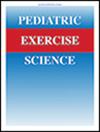间歇性有氧运动对重型β-地中海贫血青少年肝素、铁蛋白和肝酶的急性和慢性影响
IF 1.3
4区 医学
Q3 PEDIATRICS
引用次数: 0
摘要
目的本研究旨在确定间歇性有氧运动对重型地中海贫血症青少年血色素、铁蛋白和肝酶的急性和慢性影响。方法选取 26 名转诊至地中海贫血症诊所和研究中心的重型地中海贫血症青少年作为研究对象,并随机分为对照组(n = 13)和训练组(n = 13)。参与者每周进行 3 次有氧间歇运动,每次 45 分钟,持续 8 周,运动强度为心率储备的 50%至 65%。分别在运动前、运动后和最后一次训练 48 小时后采集血液样本,并评估肝酶天冬氨酸氨基转移酶、丙氨酸氨基转移酶(ALT)、碱性磷酸酶(ALP)、铁蛋白和降血脂素。结果结果显示,经过 8 周的有氧间歇训练后,天门冬氨酸氨基转移酶、谷丙转氨酶、谷草转氨酶、铁蛋白和肝素水平均有所下降(分别为 P = .14、P = .97、P = .03、P < .001 和 P < .001)。除谷丙转氨酶和降血钙素外,所有变量的组间变化均显著(P < .05)。此外,急性有氧运动增加了天门冬氨酸氨基转移酶、谷丙转氨酶、铁蛋白和肝磷脂水平(分别为P = .04、P = .52、P < .001、P < .001),而ALP水平下降(P < .001)。根据研究结果,可以得出结论:8 周的有氧间歇训练可以降低铁蛋白和降血磷素水平,但急性有氧运动会增加铁蛋白和降血磷素水平。本文章由计算机程序翻译,如有差异,请以英文原文为准。
Acute and Chronic Effects of Interval Aerobic Exercise on Hepcidin, Ferritin, and Liver Enzymes in Adolescents With Beta-Thalassemia Major.
PURPOSE
This study aimed to determine the acute and chronic effects of interval aerobic exercise on hepcidin, ferritin, and liver enzymes in adolescents with beta-thalassemia major.
METHODS
Twenty-six beta-thalassemia major adolescents referred to the Thalassemia Clinic and Research Center were selected as study participants and randomly divided into control (n = 13) and training (n = 13) groups. Participants performed 3 sessions per week for 45 minutes in each session for 8 weeks of aerobic interval exercise with an intensity of 50% to 65% of the heart rate reserve. Blood samples were taken before, immediately after the exercise session, and 48 hours after the last training session, and liver enzymes aspartate aminotransferase, alanine aminotransferase (ALT), alkaline phosphatase (ALP), ferritin, and hepcidin were evaluated.
RESULTS
The results showed a decrease in aspartate aminotransferase, ALT, ALP, ferritin, and hepcidin levels due to 8 weeks of aerobic interval training (P = .14, P = .97, P = .03, P < .001, P < .001; respectively). Intergroup changes in all variables except ALT and hepcidin were significant (P < .05). Besides, acute aerobic exercise increased levels of aspartate aminotransferase, ALT, ferritin, and hepcidin (P = .04, P = .52, P < .001, P < .001; respectively), whereas ALP levels decreased (P < .001). In addition, changes in ALP and hepcidin levels were significant between the 2 groups (P = .05, P < .001; respectively).
CONCLUSION
Based on the study's results, it can be concluded that 8 weeks of aerobic interval training can decrease ferritin and hepcidin levels, but acute aerobic exercise increases them.
求助全文
通过发布文献求助,成功后即可免费获取论文全文。
去求助
来源期刊

Pediatric Exercise Science
医学-生理学
CiteScore
2.80
自引率
0.00%
发文量
33
审稿时长
>12 weeks
期刊介绍:
Pediatric Exercise Science is a journal committed to enriching the scientific knowledge of exercise during childhood and adolescence. To this end it publishes information that contributes to an understanding of (a) the unique aspects of the physiologic, physical, biochemical, and psychologic responses of children to exercise, (b) the role of exercise in the treatment of pediatric chronic diseases, (c) the importance of physical activity in the prevention of illness and preservation of wellness, and (d) the means by which participation in sports may be made safer and more enjoyable for children and youth. Consideration will be given for publication of work by various methodologies consistent with the scientific approach.
Besides original research, the journal includes review articles, abstracts from other journals, book reviews, and editorial comments. Pediatric Exercise Science encourages the expression of conflicting opinions regarding children and exercise by providing a forum for alternative viewpoints. At the same time it serves as a means of accumulating a base of research information that will allow application of experimental data to clinical practice. The scientific disciplines contributing to this body of knowledge are diverse. Therefore it is the purpose of this journal to provide a common focus for disseminating advances in the science of exercise during childhood. In doing so, the journal allows the opportunity for cross-fertilization of ideas between disciplines that will potentiate the growth of knowledge in this field. Pediatric Exercise Science seeks to stimulate new ideas regarding exercise in children and to increase the awareness of scientists, health care providers, and physical educators of the importance of exercise during childhood.
 求助内容:
求助内容: 应助结果提醒方式:
应助结果提醒方式:


